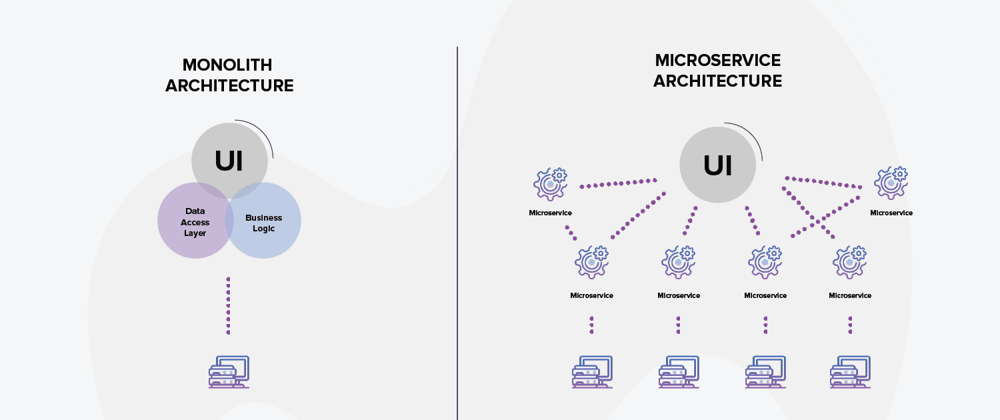Using microservices architecture means creating applications through loosely coupling services. Every service represents a system component that can be created and maintained separately, executing an independent business goal.
There has been a lot of buzz about transitioning from monolith to microservices. Let's see what's that all about.
Monolith Architecture
The monolithic approach means creating the application as a single unit that contains all the functional components, including database operations, business logic, background processing, etc. They are all deployed together at the same time and running on the same servers.
There are several benefits that monolith architecture brings. First of all, it’s very convenient to develop a simple application as everything’s in the same language and framework.
Second, they are easy to test. End-to-end testing can be performed by simply launching the entire application.
Finally, there’s only one application being released every time something new is added.
However, all these benefits carry their own difficulties. Deploying the entire application when you only need to make a small change is too complicated and unnecessary.
When there’s a small bug that only requires the change of only a few lines of code, you need to create a new build for the entire system and deploy it again. This can take days, sometimes even weeks.
Scaling is an even bigger issue. Scaling just a part of the system is impossible — you have to scale the entire system instead. This makes the creation of innovation much more difficult. Organizations struggle with becoming agile because every action takes too much time and effort.
Microservices Architecture
On the other hand, the microservices approach designs applications as a set of small services. Every service is a separate application with its own framework, programming language, and database. They are all developed and deployed separately from other services. They communicate through inter-process communication protocols like HTTP, AMQP, or a binary protocol like TCP.
Complex applications with a large number of components that need to scale require a microservices architecture. Amazon, Netflix, eBay, Uber, Groupon, and SoundCloud, are only some of the worldwide giants that have adopted microservices.
Here are the advantages you’ll get if you migrate to microservices:
Scalability
As the architecture of microservices is based on small components, scaling is so much easier than in a monolith architecture. This means that when big changes happen in a certain component, the others remain untouched and run correctly. This is a great approach for companies that work on a large number of devices and applications.
Flexibility
The microservices approach doesn’t limit developers in terms of tools and technologies. Each service can be built with a different framework and language. That simplifies the selection of the most suitable technology for your service’s specific needs. The fact that components are different doesn’t affect the work of other microservices or the communication between them by no means.
Moreover, some of the technology-related challenges are easier to solve in some technologies more than in others. Microservices don’t limit you when it comes to technology use, unlike monolith architecture where you’re stuck with the same technology during the entire process.
Increased productivity
Microservices are easy to develop and this process doesn’t take up too much time. They allow several teams to work on different components from the same app without affecting the work of other services. There’s no need for waiting for one team to finish so that the other can start working.
Moreover, microservices can be easily moved and modified. This allows testers to test separate services individually and get more done in a shorter period of time, without having to wait for the entire application to be ready.
Easier communication in distributed teams
Remote teams can function much easier if they are working with microservices architecture. Developing a monolith system with team members being all around the world can be a mission impossible. Microservices give developers the freedom to work independently without having to wait for the entire team to make every decision.
Maintenance
Debugging an application has finally become pain-free. Due to the smaller size of microservices, detecting an error and repairing it gets done in no-time. Teams have more control over these small instances of code and the probability to deliver error-free applications is larger.
However, when you have a lot of building blocks, it can be tricky to discover exactly where the problem has arisen. That’s why it’s smart to use monitoring tools that will help you react to problems more efficiently.
When should you transition to microservices?
Although microservices bring many benefits for large products that have a lot of developers working on them, smaller projects are usually built with monoliths. Monoliths are cheaper to develop and launch because they consist of a single code base. That’s why transitioning to microservices should be a well-planned and decision based on the needs and the power of the company.
Companies that are growing should seriously consider microservices as an architecture. The most common reasons teams migrate to microservices are scalability and productivity challenges. Projects that are growing require more developers, so allowing them to focus on a single service of the application makes things much easier.
If they are working with monolith architecture, they all have access to the same code base. In this case, the smallest change can disrupt the communication between teams and change the entire application. The need for frequent testing is bigger so that conflicts can be avoided and this slows down the entire release process, reducing the productivity of entire departments.
Microservices eliminate all these issues. They allow immediate releases, as CI/CD pipelines are easily integrated. Deployments can happen thousands of times a day. At the same time, the application is running as usual, as it consists of many different small components.
Conclusion
Microservices aren’t the perfect solution. Their choice depends on the project and the team structure. Migrating can be a very challenging task for the entire team, so it should be seriously discussed.
However, the benefits that this system can bring are much more significant on a long-term basis. It brings simplicity, robustness, increased productivity, and easier maintenance. Most importantly, it makes your developers happy and stress-free :)
Need help with transitioning to microservices? Check out Microtica! We automate the entire software delivery process and allows developers to write and run software reliably and at scale. Fell free to tell me what you think!







Oldest comments (0)